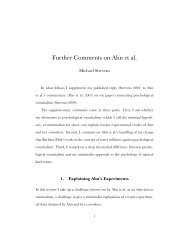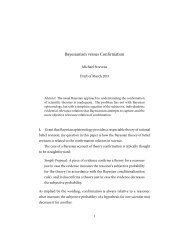The Essentialist Aspect of Naive Theories - Michael Strevens
The Essentialist Aspect of Naive Theories - Michael Strevens
The Essentialist Aspect of Naive Theories - Michael Strevens
Create successful ePaper yourself
Turn your PDF publications into a flip-book with our unique Google optimized e-Paper software.
4.2.2 Insides Versus Lineage in the Discovery Experiments<br />
Recall from section 2.2 that the explanation <strong>of</strong> Keil’s discovery experiments<br />
requires two hypotheses:<br />
<strong>The</strong> lineage hypothesis: Children believe that members <strong>of</strong> a kind invariably<br />
have <strong>of</strong>fspring <strong>of</strong> the same kind, and<br />
<strong>The</strong> insides hypothesis: Children believe that members <strong>of</strong> a kind invariably<br />
have kind-specific insides.<br />
Either hypothesis could explain children’s responses to the discovery experiments.<br />
But in fact, they seem to play roughly equal roles in the explanation:<br />
interviews with children during the experiments show that the children<br />
appeal to lineage about as <strong>of</strong>ten as they appeal to insides to explain their<br />
K-patterned inferences. I assume that this is because the two hypotheses<br />
carry equal weight, on average, for the children. (It would be interesting to<br />
conduct the experiment twice more, giving only information about lineage,<br />
then only information about insides.)<br />
Internal essentialism incorporates the insides hypothesis, but not the lineage<br />
hypothesis. It follows that the internal essentialist child gets the relationship<br />
between insides and kind for free, but must learn the relationship<br />
between lineage and kind. According to internal essentialism, then, children’s<br />
grasp <strong>of</strong> the relationship between insides and kind ought to come<br />
earlier than their grasp <strong>of</strong> the relationship between lineage and kind. Why,<br />
then, do the children in Keil’s experiment appeal to lineage as <strong>of</strong>ten as they<br />
appeal to insides?<br />
I consider three responses on behalf <strong>of</strong> the internal essentialist. <strong>The</strong><br />
first concerns timing: it may be that children learn about lineage at the<br />
same time that they become essentialists. This suggestion squanders the<br />
advantage that internal essentialism has over the other explanations <strong>of</strong> the<br />
K-patterns: if children can learn about lineage at the same time that they<br />
are becoming essentialists, surely they can learn about insides, too. <strong>The</strong>n<br />
there is no motivation to incorporate the insides hypothesis (or any other<br />
like it) in the essentialist hypothesis.<br />
<strong>The</strong> second internal essentialist response is to attempt to incorporate the<br />
lineage hypothesis in internal essentialism, that is, to posit that the beliefs<br />
attributed by the lineage hypothesis are entailed by the child’s conception<br />
<strong>of</strong> essence. It would have to be argued that it is a consequence <strong>of</strong> the child’s<br />
conception <strong>of</strong> essence that organisms with a certain essence always have<br />
22






